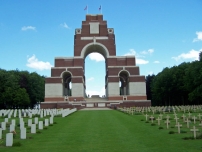| First Name: | William Thomas | Last Name: | WATSON | |
|---|---|---|---|---|
| Date of Death: | 05/09/1916 | Lived/Born In: | Earlsfield | |
| Rank: | Private | Unit: | East Surrey1 | |
| Memorial Site: | Thiepval Memorial, France | |||
Current Information:Age-20 58, Summerley Street, Earlsfield Born-Kennington
The Battle of the Somme (July-November, 1916) By the beginning of September, 1916, the Battle of the Somme had been raging for two months. Thousands of men had already been killed or wounded or were simply missing, never to be seen again and and just a few square miles of the French countryside, all in the southern part of the battlefield, had been captured from the enemy. Mistakes had been made by the various commanders and would be continued to be made but there was no turning back as the British, Australians, South Africans, New Zealanders and Canadians carried on battering away at the German defences in the hope of a breakthrough, So it continued all the way through to November with nearly every battalion and division then in France being drawn into it at some stage. In the end the German trenches had been pushed back a few more miles along most of the line but the cost in lives had been staggering. By the end of the fighting in November, 1916, British Army casualties numbered over 400,000, killed, wounded and missing. The German second line ran through the village of Guillemont in the southern part of the battlefield and all attempts to capture it through July and August, 1916 had failed. The ferocity of the battle there had transformed the area into something aptly described in the History of The Rifle Brigade 1914-1918, by Reginald Berkeley, as “..a horror that can hardly be imagined. Not merely was the front line impossible to be held: it could only be approached by men of the most iron fortitude. The position was dangerously exposed to fire from the village; but that was nothing. What horrified the senses and shocked the imagination was not what might come from outside the trenches, but what was in them. From end to end they were choked with British dead, on their backs, on their faces, hideously doubled up, distorted with pain, blackened and bloated by the sun, the prey of myriad upon myriad of carrion flies, odiously green with corruption…like a descent to the anterooms of Hell”. Between 3rd and 6th September the village of Guillemont was attacked and captured by 5th Division and 20th Division. Guillemont was in British hands by the end of the first day of the battle and by 6th September, further gains to the east of the village had taken the front line to the edge of Leuze Wood. At noon on 3rd September, 1916, 1st Cornwall Light Infantry and 12th Gloucestershire, both of 95 Brigade, 5th Division, attacked the German trenches on the Leuze Wood spur. With some losses they captured the much battered trenches along with dug-outs and machine gun posts on the near slope of the depression opposite Wedge Wood. Fifty minutes later they continued their advance and the German 2nd line from Wedge Wood to south-east of Guillemont was taken. 1st East Surrey of 95 Brigade were in support of 1st Cornwall and when the attack began they occupied the trenches vacated by the Cornish battalion. Here they remained for the rest of the day and during the night two of the companies moved forward to begin the relief of 1st Cornwall on the 3rd objective. The following day, 4th September, these two companies moved further forward up to Leuze Wood but were not significantly engaged with the enemy who were ceding ground to the attack. On 5th September, 1st East Surrey supported 1st Devonshire as they made further progress into Leuze Wood and also established a line of machine-gun posts, linking them with 95 Brigade on their right. The casualties sustained by 1st East Surrey on this day came mainly from artillery fire, some of which originated from their own guns falling short. Among those killed was William Watson. |
||||
| « Back to Search Results | ||||
| If you think any of the information shown here is incorrect, Click Here to submit your amends and comments | ||||




